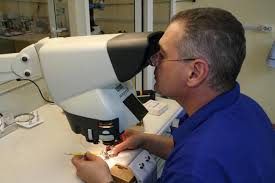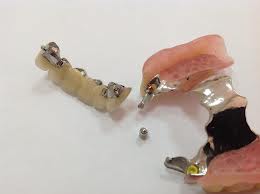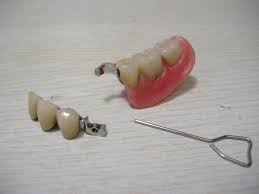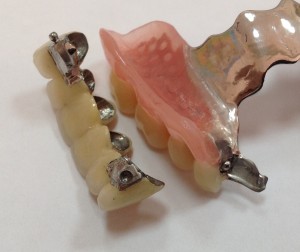Fixing an arch prosthesis

Clasp dentures have a certain service life.
During operation, they are subject to certain wear and tear and, as a result, cease to properly perform their functions. To avoid this, it is necessary to regularly carry out structural correction.
Unfortunately, most patients do not visit the dentist for the purpose of a routine examination, which excludes the possibility of the dentist providing full assistance. As a result, the dental structure is used in violation of the operating rules.
But even if during the manufacture of the prosthesis all standards are met and its operation is carried out according to the requirements, no one is immune from structural failure.
According to average statistics, in the first year of using dentures made of modern materials, structural failure occurs in about 10% of cases.
Causes of breakdowns
Damage to clasp prostheses can be associated not only with deterioration of the structure, but with the adverse effects of external factors.
Failure factors:
- Strong load on the structure.
- The low quality of the original denture.
- Insufficient quality connection between the base, teeth and frame.
- Inadequate maintenance of the structure.
- Prolonged exposure to the prosthesis at high or low temperatures.
- If the patient suffers from gnashing of teeth, then the load on the structure increases, the risk of damage to it increases.
- Denture fall during use (when cleaning, removing or fixing).
- An attempt to independently rebase the structure.
Type of breakdown

- During the operation of clasp prostheses, a breakdown of the orthopedic structure or its parts (fixtures, teeth) can occur.
- If the structure falls on a hard surface, it may crack or fracture, or metal mounts may break off.
- In some situations, loss or breaking of an artificial tooth occurs.
What to do
If the prosthesis is damaged, it must be repaired or restored.
If clasp prosthesis is broken, actions should be as follows:
It is necessary to call or come to the clinic where the prosthesis was installed and will receive specialist advice.
See a doctor to assess the situation and get further action.
The arch prosthesis is repaired in a dental laboratory. If it is impossible to repair the structure, they will offer to make a new prosthesis.
Repairing a prosthesis takes one to two days, depending on the complexity of the structural failure.
In order to make a new design will take one week.Keep in mind the following: if the warranty period has not expired (usually it is one year), then the arch prosthesis is repaired or a new one is made free of charge. If the warranty period has ended, then the service must be paid.
If the denture was originally made poorly, then a self-respecting clinic will repair the denture or make a new one for free.
If the clinic refuses to plead guilty, you can go to court with a lawsuit about the poorly provided service.
When is a repair needed?

- If there is a fracture of the cast frame of the structure, then the prosthesis must be completely redone.
- If the stamped structure breaks down, it is impossible to repair it, because The manufacturing quality criteria for such a prosthesis are very strict and the appearance of any defect is an occasion for the manufacture of a new design.
- Repairing the prosthesis base is easy.
- If there is a need to relocate the structure.
- Fracture cast clasp presents a certain complexity. If it is possible to replace the clammer’s molded shoulder with a bent one, the repair is simplified.
- When the arch of the clasp construction is broken, repair is impossible.
- The presence of cracks in the base can be removed in the presence of the patient.
- If necessary, replace the sleeve in the design lock.
- A lost or broken tooth is put in place.
- Damage to the prosthesis lock.
- If there is a loss of an abutment.
As a result of repair, dentures lose their strength a little, but nevertheless, restoration of a dental structure is cheaper than manufacturing a new denture. Dentures broken even in three places can be repaired.
How to repair

- For fractures and cracks in the denture, gluing and sealing of individual parts using dental resins is used. The appearance and functionality of the design does not deteriorate.
- When changing stains, it is better to professionally clean the structure.
- If artificial teeth have broken off or fallen out - you can make new ones or return the fallen ones, but using special techniques and devices, etc. K. tooth positioning affects chewing.
- The fracture of the saddle-shaped part of the structure can be repaired by gluing with wax, which is superimposed along the fracture line.
- When a metal frame is fractured, a delayed repair procedure is used. If it is impossible to use laser welding, the plastic basis of the structure during repair will be damaged.
- With the loss of the abutment, for which the structure was fixed, in the conditions of a dental laboratory, welding of an artificial tooth is possible, which will replace the lost one.
Is it possible to repair the prosthesis myself
Self-repair can provoke further destruction of the structure, which will affect the change in the bite, the appearance of discomfort and impaired oral function.
Do not engage withIndependent repair of the denture (gluing parts of it) for the following reasons:
- Industrial glue may cause an allergic reaction or poisoning.
- A small chip on the fault, the industrial glue cannot be filled, and after its application a defect will form, which will lead to repeated breakage.
- The physical features of the adhesive differ from the material of which the prosthesis is made, therefore, the integrity of the structure will soon be violated.
- The surface of the seam at the place of gluing is a source of reproduction of pathogens and bacteria.
- After self-repair, the specialist will not be able to restore the integrity of the structure.
Professional repair of arch prostheses guarantees the quality of restoration, which prevents further damage to the structure and its harmful effect on teeth and gums. The patient receives a comfortable and functional design on the same day.
After repair
After repairing the structure, Mandatory correction of her position in the mouth is required.
Therefore, after repairing the prosthesis, you should contact your dentist in the near future and, if necessary, relocate the prosthesis.
Breakdown prevention
An important point is the implementation of recommendations for care and timely correction of the prosthesis.
Here are some rules:
- The prosthesis should be cleaned over a container with water, or over a soft surface (for example, a folded terry towel) so that, in case of accidental fall, the structure is not damaged.
- Do not bite hard objects: nuts, pieces of ice, gnaw threads, pencils, etc.
- Visit your dentist at least once every six months.